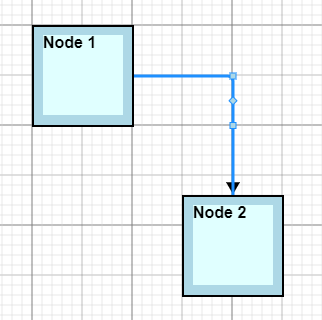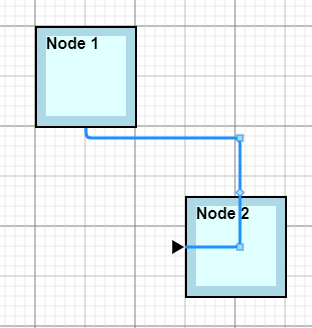I am witnessing some odd behavior for the link routing. Hoping you can help fix this.
I have a simple example using a diagram model with two nodes connected as shown. The picture here is initialized on startup in the node and link arrays.

- The first behavior which Im trying to understand is fix, is the way that link routing changes when I draw it interactively. For example in the above diagram, if I delete the link (as initialized) and then reconnect the nodes using the mouse I get this picture:

This seems strange to me, because surely it should follow the same route. And if I save the model and reload it, I would want the links to be drawn consistently in the manner they were saved.
-
Secondly, I seem to be having trouble trying to manually redraw the link paths. I have set
reshapable: true,
resegmentable: true
in the link template, but when I try to move the link, i get errors. For example, when I start with the first picture shown above (on initialization) and try to redraw the link to look like the second picture I get this:

This clearly not what I want. Appreciate it, if you can shed some light on this.
Thanks.
Here is the code:
<!DOCTYPE html>
<html lang="en">
<head>
<meta charset="utf-8" />
<meta name="viewport" content="width=device-width, initial-scale=1, shrink-to-fit=no, viewport-fit=cover" />
<meta name="description"
content="Node link Test" />
<script src="https://unpkg.com/gojs/release/go-debug.js"></script>
<script>
function init() {
var $ = go.GraphObject.make; // for conciseness in defining templates
var diagram = $(go.Diagram, "myDiagramDiv"
, {
allowDrop: true
, allowDelete: true
, allowCopy: true
, "grid.visible": true
}
);
var nodeTemplate =
$(go.Node, "Auto", // the whole node panel
{
selectionAdorned: true
, resizable: true
}
, new go.Binding("location", "loc")
, $(go.Shape, "Rectangle", // spot positions in the the mopde are aligned with respect to this
{
fill: "lightblue"
, strokeWidth: 2
, desiredSize: new go.Size(100, 100)
, portId: ""
, cursor: "crosshair"
, fromLinkable: true, fromLinkableDuplicates: true
, toLinkable: true, toLinkableDuplicates: true
, fromSpot: go.Spot.AllSides
, toSpot: go.Spot.AllSides
}
)
,
$(go.TextBlock,
{
name: "TitleTextBlock"
, alignment: go.Spot.Top
, alignmentFocus: go.Spot.Top
, font: "bold 16px sans-serif"
, margin: 10
, desiredSize: new go.Size(80, 80)
, editable: true
, text: "node"
, background: "lightcyan"
}
, new go.Binding("text", "nodeTitle")
)
); // end Node
var linkTemplate =
$(go.Link
, { selectionAdorned: true
, routing: go.Link.Orthogonal, corner: 5
, reshapable: true
, resegmentable: true
, toEndSegmentLength: 20
//, fromEndSegmentLength: 20
//, toShortLength: 40
}
, new go.Binding("points").makeTwoWay()
, $(go.Shape,
{ strokeWidth: 2 }
)
, $(go.Shape, // arrowhead
{ toArrow: "Triangle", stroke: null, scale: 1.5 }
)
);
var nodeDataArray = [
{ key: "N1", nodeTitle: "Node 1", loc: new go.Point(0, 0) },
{ key: "N2", nodeTitle: "Node 2", loc: new go.Point(150, 170) },
];
var linkDataArray = [
{ from:"N1", to:"N2" }
]
diagram.nodeTemplate = nodeTemplate;
diagram.linkTemplate = linkTemplate;
diagram.model = new go.GraphLinksModel(nodeDataArray, linkDataArray);
}
window.addEventListener('DOMContentLoaded', init);
</script>
</head>
<body>
<div id="myDiagramDiv" style="border: solid 1px blue; width:1000px; height:1000px"></div>
</body>
</html>